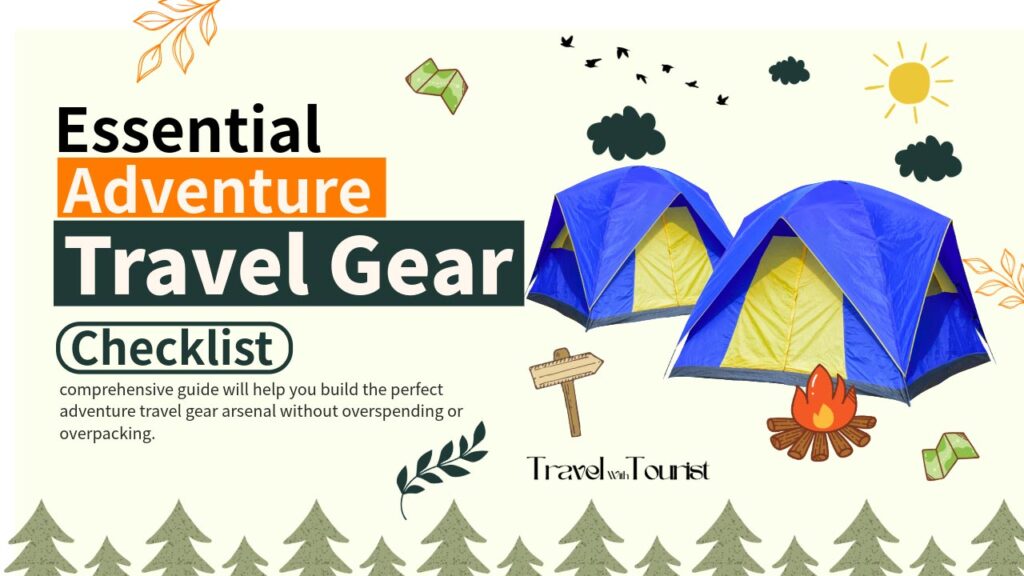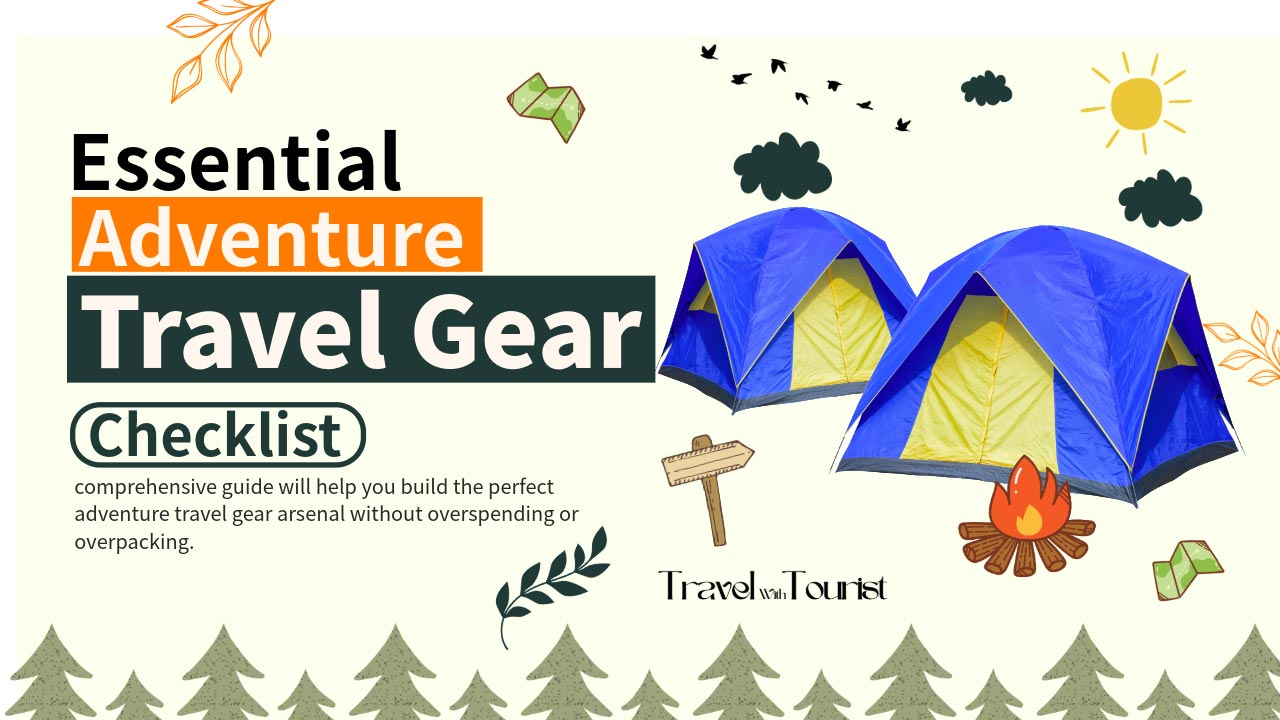Picture this: You’re halfway up a mountain trail when the weather suddenly turns, and you realize your “waterproof” jacket is about as effective as a paper towel.
We’ve all been there!
In fact,
Studies show that 73% of adventure travel mishaps could have been prevented with proper gear preparation.
The difference between an epic adventure and a survival story often comes down to what is in your backpack.
I learned this lesson the hard way during my first multi-day hiking trip.
Cheap gear failures left me cold, wet, and questioning my life choices at 3 AM in a leaky tent.
But here’s the good news – you do not need to break the bank or own every piece of gear on the market to have incredible adventures!
After years of testing equipment across six continents and countless adventures,
I’ve discovered that success isn’t about having the most expensive gear – it’s about having the right gear for your specific adventure.
Whether you’re planning your first weekend camping trip or gearing up for a month-long expedition, this comprehensive guide will help you build the perfect adventure travel gear arsenal without overspending or overpacking.
Let us dive in!

Adventure Travel Gear Essentials: The Foundation of Every Trip
The secret to successful adventure travel lies in building a solid foundation of versatile, reliable gear that can adapt to various situations.
Think of your gear collection as a pyramid – you need a strong base of essentials before adding specialized equipment for specific activities.
Core gear categories every adventure traveler needs
Your core gear categories should include navigation and safety equipment, clothing and layering systems, shelter and sleep essentials, cooking and hydration tools, and basic electronics.
The beauty of focusing on these fundamentals is that they will serve you whether your day hiking in your local mountains or trekking through remote wilderness areas.
Quality vs. quantity approach to gear selection
Quality should always trump quantity when building your adventure travel gear collection.
One well-made piece of equipment that lasts for years is infinitely more valuable than three cheap items that fail when you need them most.
Multi-use items that maximize space and value
Look for gear that serves multiple purposes – a good example is a lightweight down jacket that works as both a pillow and insulation layer.
Seasonal considerations for gear selection
Seasonal considerations play a crucial role in gear selection.
Your summer desert hiking kit will look vastly different from your winter mountaineering setup.
Many items can transition between seasons with proper layering strategies and smart additions to your core collection.
How to prioritize gear purchases for beginners
For beginners, I recommend starting with the absolute essentials and gradually building your collection based on your actual adventure experiences.
Don’t fall into the trap of buying everything at once – you’ll likely end up with gear that doesn’t match your adventure style or needs.
Navigation and Safety Equipment for Adventure Travel
Navigation and safety equipment form the backbone of any adventure travel gear collection.
These items can literally save your life, making them non-negotiable investments for any serious adventurer.
GPS devices and smartphone navigation apps
Modern GPS devices and smartphone navigation apps have revolutionized adventure travel, but they shouldn’t replace traditional navigation skills.
A quality GPS unit with pre-loaded maps, long battery life, and durability features is essential for any multi-day adventure.
Popular options include Garmin’s eTrex series and more advanced models like the GPSMAP series for serious backcountry use.
Traditional navigation tools (compass, maps, altimeter)
Traditional navigation tools remain crucial backups when technology fails.
A reliable compass, detailed topographic maps, and an altimeter provide redundancy that could save your life in emergency situations.
Learn to use these tools before you need them – practice makes perfect when it comes to navigation skills.
Emergency communication devices (satellite messengers, PLBs)
Emergency communication devices have become increasingly important for adventure travelers venturing into remote areas.
Satellite messengers like the Garmin inReach series allow two-way communication and SOS capabilities even when cellular service is unavailable.
Personal locator beacons (PLBs) provide one-way emergency communication but are lighter and have longer battery life.
First aid kit essentials for adventure travel
Your first aid kit should be tailored to your specific adventures and group size.
Basic supplies should include bandages, antiseptic wipes, pain relievers, blister treatment, and any personal medications.
Consider taking a wilderness first aid course to learn how to use these supplies effectively.
Emergency shelter and signaling equipment
Emergency shelter and signaling equipment round out your safety arsenal.
A lightweight emergency bivy or space blanket can provide life-saving protection in unexpected situations. Whistle, mirror, and bright fabric can help rescuers locate you if needed.
Clothing and Layering Systems for Adventure Travel
The layering system is fundamental to adventure travel clothing success.
This approach allows you to regulate your body temperature efficiently by adding or removing layers as conditions change throughout your adventure.
Base layer fundamentals and fabric choices
Base layers form the foundation of your clothing system and should wick moisture away from your skin while providing some insulation.
Merino wool offers excellent odor resistance and temperature regulation, making it ideal for multi-day adventures.
Synthetic materials dry faster and are more durable, making them perfect for high-output activities.
Insulation layer options for different climates
Insulation layers trap warm air close to your body and can be added or removed as needed.
Down insulation provides the best warmth-to-weight ratio and compresses well for packing, but loses insulation properties when wet.
Synthetic insulation maintains warmth when damp and dries quickly, making it ideal for wet environments.
Waterproof and breathable outer shell selection
Your outer shell layer protects you from wind, rain, and snow while allowing moisture to escape.
Look for jackets and pants with waterproof-breathable fabrics like Gore-Tex or similar technologies.
Features like pit zips, adjustable hoods, and reinforced high-wear areas add functionality and durability.
Adventure travel footwear guide
Adventure travel footwear requires careful consideration of your specific activities and terrain.
Hiking boots provide ankle support and durability for rocky terrain, while trail runners offer better breathability and lighter weight for less technical trails.
Consider bringing multiple footwear options for longer adventures.
Accessories and protection gear (hats, gloves, sunglasses)
Accessories and protection gear complete your clothing system.
A quality hat protects your head from sun and cold, while gloves or mittens keep your hands functional in harsh conditions.
Sunglasses are essential for high-altitude and snow travel, where UV reflection can cause serious eye damage.
Backpacks and Luggage for Adventure Travel
Your backpack is your mobile base camp, carrying everything you need to survive and thrive in the wilderness.
Choosing the right pack can make or break your adventure experience, so it’s worth investing time and money to get it right.
Choosing the right backpack size and style
Pack size depends on your adventure length and personal packing style.
Day packs (20-35 liters) work for short adventures and day hikes, while multi-day packs (40-70 liters) accommodate longer trips with camping gear.
Expedition packs (70+ liters) are necessary for extended adventures or winter camping with bulky gear.
Daypack vs. multi-day pack considerations
Internal frame packs dominate the modern adventure travel market due to their versatility and improved design.
Look for packs with adjustable torso lengths, padded hip belts, and load-compression systems.
Top-loading packs are simpler and lighter, while panel-loading packs offer better organization and access to gear.
Packing cubes and organization systems
Packing cubes and organization systems help maximize your pack’s efficiency and keep gear accessible.
Compression sacks reduce the volume of bulky items like sleeping bags and clothing.
Dry bags protect essential items from moisture and help organize gear by category.
Durability features to look for in adventure luggage
Durability features separate quality adventure packs from inferior models.
Look for reinforced stress points, quality zippers, and ripstop fabrics that can withstand rough handling.
Many quality packs come with repair guarantees or services that extend their usable life significantly.
Travel bags for different adventure activities
Different adventure activities may require specialized luggage solutions.
Water-based adventures need waterproof dry bags, while climbing expeditions require specialized hauling systems.
Consider your specific adventure needs when selecting luggage options.
Shelter and Sleep Systems for Outdoor Adventures
Quality sleep in the outdoors directly impacts your adventure performance and safety.
Your shelter and sleep system should provide protection from the elements while maintaining comfort and packability for your specific adventure type.
Tent selection guide for different environments
Tent selection depends on your adventure style, group size, and expected conditions.
Ultralight backpacking tents prioritize weight savings and packability, while car camping tents offer more space and comfort.
Four-season tents provide protection from extreme weather but weigh more and cost significantly more than three-season options.
Sleeping bag temperature ratings and fill types
Sleeping bag temperature ratings indicate the lowest temperature where an average person can sleep comfortably.
Choose a bag rated 10-15 degrees below the lowest expected temperature for your adventure.
Down fill provides better warmth-to-weight ratios and compressibility, while synthetic fill maintains insulation when wet and costs less.
Sleeping pad options for comfort and insulation
Sleeping pads provide crucial insulation from ground cold and improve comfort significantly.
Closed-cell foam pads are durable and lightweight but less comfortable than inflatable options.
Air pads offer excellent comfort and packability but can puncture.
Self-inflating pads combine foam and air for a balance of comfort and reliability.
Pillow alternatives and comfort accessories
Pillow alternatives can significantly improve sleep quality without adding much weight.
Inflatable pillows pack small and provide good support, while stuff sacks filled with extra clothing offer versatility.
Some sleeping pads include integrated pillow systems for streamlined packing.
Shelter considerations for different adventure types
Shelter considerations vary dramatically between adventure types.
Mountaineering requires four-season protection and wind resistance, while desert camping prioritizes ventilation and UV protection.
Research your specific destination’s typical conditions when selecting shelter systems.
Cooking and Hydration Gear for Adventure Travel
Proper nutrition and hydration are essential for adventure travel performance and safety.
Your cooking and hydration systems should be reliable, efficient, and appropriate for your adventure’s length and remoteness.
Portable stove systems and fuel considerations
Portable stove systems come in various fuel types, each with advantages and disadvantages.
Canister stoves are convenient and efficient but fuel availability varies internationally.
Liquid fuel stoves work in extreme conditions and use widely available fuels but require more maintenance.
Alcohol stoves are ultralight and simple but slower and less fuel-efficient.
Cookware and utensils for outdoor cooking
Cookware selection depends on your group size and cooking ambitions.
Titanium cookware is ultralight but expensive, while aluminum offers good heat conduction at reasonable weight.
Stainless steel is durable and affordable but heavier. Non-stick coatings improve cooking performance but can wear off with heavy use.
Water filtration and purification systems
Water filtration and purification systems protect you from waterborne illnesses that can ruin your adventure.
Pump filters work quickly and handle dirty water well but are heavier and more complex.
Gravity filters are excellent for groups but require clean water sources.
UV purifiers are lightweight and fast but don’t remove sediment or chemicals.
Hydration pack vs. water bottle pros and cons
Hydration pack versus water bottle choice depends on your activity and personal preference.
Hydration packs allow hands-free drinking and carry more water but can be difficult to clean and monitor consumption.
Water bottles are simple and reliable but require stopping to drink and may freeze in cold conditions.
Food storage and bear-proof containers
Food storage and bear-proof containers are essential in areas with active wildlife.
Bear canisters are required in many wilderness areas and provide foolproof protection but add weight and bulk.
Rope hanging systems work well but require proper technique and suitable trees.
Electronic Devices and Power Solutions
Modern adventure travel increasingly relies on electronic devices for navigation, communication, and documentation.
Your electronic systems should be reliable, weatherproof, and supported by adequate power solutions for your adventure length.
Essential electronics for adventure travel
Essential electronics for adventure travel include GPS devices, emergency communication tools, and lighting systems.
Smartphones can serve multiple functions but require backup power and weather protection.
Dedicated devices often perform better in extreme conditions and have longer battery life.
Camera gear for capturing your adventures
Camera gear for adventure travel requires balancing image quality with weight and durability.
Action cameras like GoPros excel in extreme conditions and activities, while mirrorless cameras offer better image quality with reasonable weight.
Smartphone cameras continue improving and eliminate the need for separate devices for many adventures.
Portable power banks and solar chargers
Portable power banks and solar chargers extend your electronic device runtime in remote areas.
Choose power banks with capacity appropriate for your adventure length and device requirements.
Solar chargers work well in sunny conditions but are less reliable in cloudy or forested environments.
Headlamps and lighting solutions
Headlamps and lighting solutions are essential for any adventure extending into darkness.
LED technology has revolutionized adventure lighting with improved efficiency and durability.
Choose headlamps with multiple brightness settings, red light options for night vision preservation, and adequate battery life for your needs.
Weather radio and emergency electronics
Weather radio and emergency electronics provide crucial safety information and communication capabilities.
NOAA weather radios offer detailed forecasts and severe weather warnings.
Emergency radios with hand crank or solar charging ensure communication capability even when batteries die.
Budget-Friendly Adventure Travel Gear Strategies
Building a quality adventure travel gear collection doesn’t require unlimited funds.
Smart shopping strategies, timing, and prioritization can help you acquire excellent gear without breaking the bank.
Where to find quality gear at discounted prices
Seasonal sales and gear swap opportunities provide significant savings on quality adventure equipment.
End-of-season clearances often feature 30-50% discounts on previous year’s models.
Gear swaps and consignment shops offer tried-and-tested equipment at fraction of retail prices.
Renting vs. buying adventure equipment
Renting versus buying adventure equipment makes financial sense for specialized or infrequently used items.
Rental shops near popular adventure destinations offer high-quality gear without the investment or transportation challenges.
Consider renting expensive items like mountaineering equipment or specialized camping gear for single-use adventures.
DIY gear modifications and repairs
DIY gear modifications and repairs can extend equipment life and improve performance.
Basic sewing skills allow you to repair torn fabrics and add custom features.
Seam sealing, waterproofing treatments, and zipper repairs can resurrect failing equipment and save money.
Seasonal sales and gear swap opportunities
Group purchases and bulk buying can reduce individual costs for expensive items.
Coordinate with adventure partners to share costs for group gear like tents, cooking equipment, and safety items.
Many retailers offer discounts for bulk purchases or group orders.
Building your gear collection gradually
Building your gear collection gradually allows you to learn what you actually need versus what marketing tells you to buy.
Start with essentials and add specialized items based on your actual adventure experiences.
This approach prevents expensive mistakes and ensures every piece of gear serves a real purpose.
Destination-Specific Gear Considerations
Different adventure destinations require specific gear considerations to ensure safety and comfort.
Understanding these requirements helps you pack appropriately and avoid costly mistakes or dangerous situations.
Cold weather adventure gear essentials
Cold weather adventure gear must handle extreme temperatures, wind, and moisture while maintaining functionality.
Insulation layers become more critical, and equipment like sleeping bags and boots need higher temperature ratings.
Battery performance decreases in cold conditions, requiring backup power solutions and insulated storage.
Hot climate and desert adventure equipment
Hot climate and desert adventure equipment focuses on sun protection, ventilation, and heat management.
Lightweight, light-colored clothing reflects heat while providing coverage.
Increased water capacity and electrolyte replacement become essential. Shelter systems need enhanced ventilation and UV protection.
Water-based adventure travel gear
Water-based adventure travel gear requires waterproof protection and quick-drying materials.
Dry bags protect essential items from moisture, while quick-dry clothing prevents hypothermia from wet conditions.
Specialized footwear provides traction on wet surfaces and protection from sharp objects.
High-altitude adventure preparations
High-altitude adventure preparations include gear for reduced oxygen, intense UV exposure, and rapid weather changes.
Sunglasses and sunscreen become essential, while clothing systems need versatility for rapid temperature swings.
Altitude sickness medications and monitoring equipment may be necessary for extreme elevations.
International travel gear considerations
International travel gear considerations include electrical adapters, customs regulations, and fuel availability.
Research destination-specific requirements for camping fuels, knife regulations, and electronic device restrictions.
Consider shipping gear ahead or purchasing consumables locally to avoid customs issues.
Packing and Organization Tips for Adventure Travel
Efficient packing transforms your adventure travel experience by improving accessibility, weight distribution, and gear protection.
These strategies help you make the most of your pack’s capacity while keeping essential items easily accessible.
Efficient packing strategies for different trip lengths
Weight distribution and balance techniques prevent fatigue and injury during long adventures.
Heavy items should sit close to your back and in the middle third of your pack.
Distribute weight evenly between left and right sides, and adjust load lifters to maintain proper balance.
Weight distribution and balance techniques
Packing strategies vary based on trip length and activity type. Day hikes require easy access to water, snacks, and weather protection.
Multi-day adventures need organized systems for camp gear, clothing, and food.
Expedition packing requires careful consideration of daily needs versus basecamp storage.
Gear accessibility and quick-access items
Gear accessibility and quick-access items should be prioritized based on frequency of use and emergency potential.
Rain gear, first aid supplies, and navigation tools need immediate accessibility.
Camp items and spare clothing can be packed deeper in your system.
Weatherproofing and protection strategies
Weatherproofing and protection strategies prevent gear damage from moisture, dust, and impact.
Dry bags protect electronics and spare clothing from water damage.
Compression sacks reduce volume while providing protection for sleeping bags and insulation layers.
Customs and airline considerations for adventure gear
Customs and airline considerations affect international adventure travel significantly.
Research destination-specific regulations for camping fuel, knives, and electronic devices. Consider shipping gear ahead or purchasing consumables locally to avoid customs complications and airline restrictions.
Conclusion
The right adventure travel gear isn’t just about having cool equipment – it’s about confidence, safety, and the freedom to push your boundaries knowing you’re prepared for whatever Mother Nature throws your way.
Remember, the best gear is the gear you know how to use properly and maintain well.
Start with the essentials and build your collection over time.
You don’t need everything at once!
Focus on quality pieces that will serve you across multiple adventures, and don’t be afraid to rent or borrow specialized gear until you’re sure it’s worth the investment.
Every piece of gear in your pack should earn its place through functionality, durability, and versatility.
Your next adventure is calling, and now you have the knowledge to answer with confidence. Begin by assessing your current gear collection, identify the gaps for your planned adventures, and start building your essential kit. The trails are waiting – make sure you’re ready for them!
Ready to gear up for your next adventure?
Start with our essential checklist and remember: the best adventure is the one you’re prepared for!



